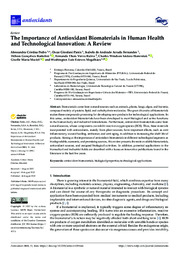The importance of antioxidant biomaterials in human health and technological innovation: a review.
The importance of antioxidant biomaterials in human health and technological innovation: a review.
Author(s): PEDRO, A. C.; PANIZ, O. G.; FERNANDES, I. A. A.; BORTOLINI, D. G.; RUBIO, F. T. V.; HAMINIUK, C. W. I.; MACIEL, G. M.; MAGALHAES, W. L. E.
Summary: ABSTRACT: Biomaterials come from natural sources such as animals, plants, fungi, algae, and bacteria, composed mainly of protein, lipid, and carbohydrate molecules. The great diversity of biomaterials makes these compounds promising for developing new products for technological applications. In this sense, antioxidant biomaterials have been developed to exert biological and active functions in the human body and industrial formulations. Furthermore, antioxidant biomaterials come from natural sources, whose components can inhibit reactive oxygen species (ROS). Thus, these materials incorporated with antioxidants, mainly from plant sources, have important effects, such as anti-inflammatory, wound healing, antitumor, and anti-aging, in addition to increasing the shelf-life of products. Aiming at the importance of antioxidant biomaterials in different technological segments as biodegradable, economic, and promising sources, this review presents the main available biomaterials, antioxidant sources, and assigned biological activities. In addition, potential applications in the biomedical and industrial fields are described with a focus on innovative publications found in the literature in the last five years.
Publication year: 2022
Types of publication: Journal article
Unit: Embrapa Forestry
Observation
Some of Embrapa's publications are published as ePub files. To read them, use or download one of the following free software options to your computer or mobile device. Android: Google Play Books; IOS: iBooks; Windows and Linux: Calibre.
Access other publications
Access the Agricultural Research Database (BDPA) to consult Embrapa's full library collection and records.
Visit Embrapa Bookstore to purchase books and other publications sold by Embrapa.

